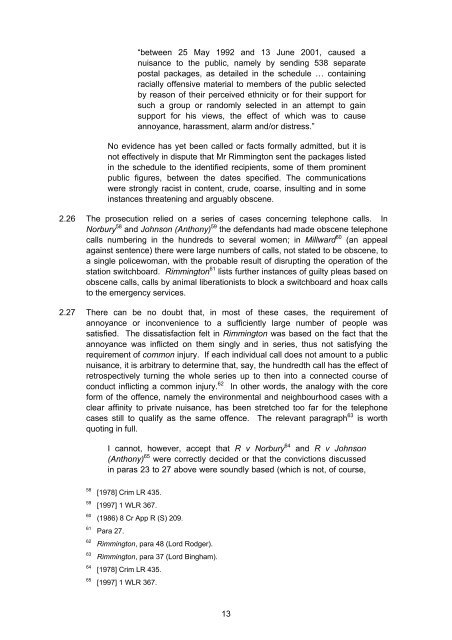public nuisance and outraging public decency - Law Commission
public nuisance and outraging public decency - Law Commission
public nuisance and outraging public decency - Law Commission
Create successful ePaper yourself
Turn your PDF publications into a flip-book with our unique Google optimized e-Paper software.
“between 25 May 1992 <strong>and</strong> 13 June 2001, caused a<br />
<strong>nuisance</strong> to the <strong>public</strong>, namely by sending 538 separate<br />
postal packages, as detailed in the schedule … containing<br />
racially offensive material to members of the <strong>public</strong> selected<br />
by reason of their perceived ethnicity or for their support for<br />
such a group or r<strong>and</strong>omly selected in an attempt to gain<br />
support for his views, the effect of which was to cause<br />
annoyance, harassment, alarm <strong>and</strong>/or distress.”<br />
No evidence has yet been called or facts formally admitted, but it is<br />
not effectively in dispute that Mr Rimmington sent the packages listed<br />
in the schedule to the identified recipients, some of them prominent<br />
<strong>public</strong> figures, between the dates specified. The communications<br />
were strongly racist in content, crude, coarse, insulting <strong>and</strong> in some<br />
instances threatening <strong>and</strong> arguably obscene.<br />
2.26 The prosecution relied on a series of cases concerning telephone calls. In<br />
Norbury 58 <strong>and</strong> Johnson (Anthony) 59 the defendants had made obscene telephone<br />
calls numbering in the hundreds to several women; in Millward 60 (an appeal<br />
against sentence) there were large numbers of calls, not stated to be obscene, to<br />
a single policewoman, with the probable result of disrupting the operation of the<br />
station switchboard. Rimmington 61 lists further instances of guilty pleas based on<br />
obscene calls, calls by animal liberationists to block a switchboard <strong>and</strong> hoax calls<br />
to the emergency services.<br />
2.27 There can be no doubt that, in most of these cases, the requirement of<br />
annoyance or inconvenience to a sufficiently large number of people was<br />
satisfied. The dissatisfaction felt in Rimmington was based on the fact that the<br />
annoyance was inflicted on them singly <strong>and</strong> in series, thus not satisfying the<br />
requirement of common injury. If each individual call does not amount to a <strong>public</strong><br />
<strong>nuisance</strong>, it is arbitrary to determine that, say, the hundredth call has the effect of<br />
retrospectively turning the whole series up to then into a connected course of<br />
conduct inflicting a common injury. 62 In other words, the analogy with the core<br />
form of the offence, namely the environmental <strong>and</strong> neighbourhood cases with a<br />
clear affinity to private <strong>nuisance</strong>, has been stretched too far for the telephone<br />
cases still to qualify as the same offence. The relevant paragraph 63 is worth<br />
quoting in full.<br />
I cannot, however, accept that R v Norbury 64 <strong>and</strong> R v Johnson<br />
(Anthony) 65 were correctly decided or that the convictions discussed<br />
in paras 23 to 27 above were soundly based (which is not, of course,<br />
58 [1978] Crim LR 435.<br />
59 [1997] 1 WLR 367.<br />
60 (1986) 8 Cr App R (S) 209.<br />
61 Para 27.<br />
62 Rimmington, para 48 (Lord Rodger).<br />
63 Rimmington, para 37 (Lord Bingham).<br />
64 [1978] Crim LR 435.<br />
65 [1997] 1 WLR 367.<br />
13

















